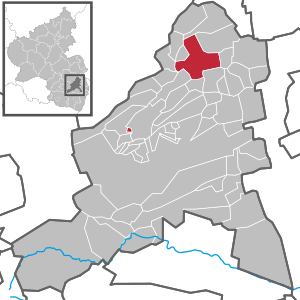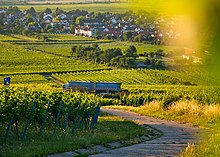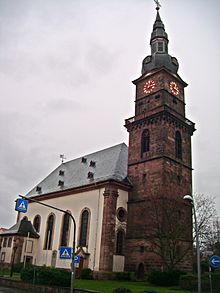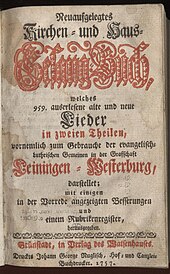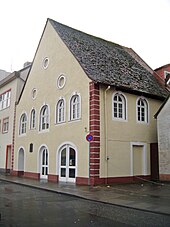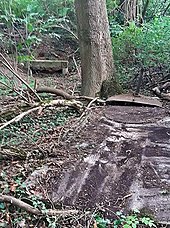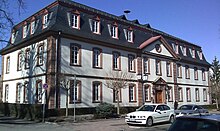Grünstadt
| coat of arms | Germany map | |
|---|---|---|

|
Coordinates: 49 ° 34 ' N , 8 ° 10' E |
|
| Basic data | ||
| State : | Rhineland-Palatinate | |
| County : | Bad Dürkheim | |
| Height : | 161 m above sea level NHN | |
| Area : | 18.09 km 2 | |
| Residents: | 13,504 (Dec. 31, 2019) | |
| Population density : | 746 inhabitants per km 2 | |
| Postal code : | 67269 | |
| Area code : | 06359 | |
| License plate : | DÜW | |
| Community key : | 07 3 32 024 | |
| City structure: | 3 districts | |
City administration address : |
Kreuzerweg 2 67269 Grünstadt |
|
| Website : | ||
| Mayor : | Klaus Wagner ( CDU ) | |
| Location of the city of Grünstadt in the Bad Dürkheim district | ||
Grünstadt [ ˈɡʀʏnːʃtat ] is an association-free city in the Bad Dürkheim district in Rhineland-Palatinate with around 13,000 inhabitants. It is the administrative seat of the community of Leiningerland , to which it does not belong.
geography
location
The city is located in the Leiningerland within the Unterhaardt on the northern border of the Palatinate Forest about ten kilometers north of Bad Dürkheim at the intersection between the German Wine Route and the A 6 . The landscape flows into the Alzeyer hill country , which is part of the Rheinhessen table and hill country .
City structure
In addition to Grünstadt itself with around 10,000 inhabitants, the districts of Asselheim with around 1,300 inhabitants and Sausenheim with around 2,300 inhabitants belong to the urban area. There is also a small parcel of land near Carlsberg , which forms an exclave of Grünstadt.
Elevations and waters
The local mountain of Grünstadt is the Grünstadter Berg, including its municipality mountain . There, above the district of Sausenheim, flows the very rich Queckbrunnen , from which a water pipe led to the Grünstadt stoneware factory in the 19th century .
Immediately to the east of the urban development rises the Floßbach , which is called Landgraben in its upper course . To the northeast of the Sausenheim district is the Sausenheimer Graben , which flows eastwards . The Eisbach flows in a west-east direction through Asselheim; there he takes the Kützelsborn from the left .
climate
The annual precipitation is very low at 529 mm. It is in the lower tenth of the values recorded in Germany. Lower values are only registered at 7% of the measuring stations of the German Weather Service . The driest month is February, with the most rainfall in June. Precipitation hardly varies and is evenly distributed over the year. Lower seasonal fluctuations are recorded at only 15% of the measuring stations .
history
Early history up to the first documentary mention
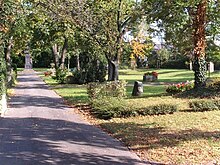
The Grünstadt area is an ancient cultural area. Mesolithic hunters from around 5000 BC have already found their way into the city . Leave their traces behind, as did farmers from the Neolithic around 2000 BC. From the Bronze Age (1500 to 750 BC), the Hallstatt Age ( 700 to 450 BC) and the Latène Age ( 450 BC to the turn of the century), there are remains of settlements and numerous archaeological finds.
In Roman times up to 450 AD there were three settlements, one of them near today's Peterspark. It is one of the germ cells of Grünstadt and was also settled in the Merovingian and Frankish periods. There the Romans had their burial place and the Christian Franks took it over. It is possible that there was a Roman burgus and a temple complex that later became a church. In any case, as early as around 800 the Alsatian Weissenburg Abbey owned a St. Peter's Church with a vicarage (the latter indicates the importance of the place), a manor with a large farm building and 14 farms.
Around the same time there was still a southern settlement in the area of today's Martinskirche , which belonged to the Lorraine monastery Glandern (also called Lungenfeld), in today's Longeville-lès-Saint-Avold , and probably also a middle settlement in between. Grünstadt only developed gradually from these three individual settlements. One of them - apparently the southern one - went back to a Frankish clan chief named "Grimdeo" or "Grindeo". In no way does the city name derive from the color "green", as has been clearly demonstrated by modern linguistic research.
875 to 1500
Green city - the Südsiedlung to St. Martin - was first mentioned on 21 November 875, when King Louis the German the abbey Glandern at Metz refunded this Hofgut. The location is already called "Grinstat" in this document and the property rights are older because they are only being restituted. This settlement was much older than the document from 875, which says nothing about the building stock. The assumption is made from a cloister courtyard with a small church, from which, via a Benedictine priory, the several times newly built, today's Protestant St. Martin's Church with burial place of the house of Leiningen-Westerburg developed.
Around the same time, around 900, the northern settlement of the Weißenburg monastery (near today's Peterspark) is listed in its inventory of properties and even described in detail, with the already mentioned property (church, rectory, manor house and numerous buildings), which was already at that time high The age of the place. The settlement later disappeared or moved south to the other two. The Peterskirche and the associated cemetery, the beginnings of which probably date back to Roman times, were still preserved as a religious center and necropolis until the 19th century, even though they were located far outside the later city of Grünstadt . The more than 1000-year-old church was demolished in 1819 and the old patronage "St. Peter" was transferred to the Capuchin Church (today's Catholic parish church). The cemetery was not closed until 1874 and converted into today's Peterspark.
In 1155, Grünstadt is mentioned in a document from Emperor Friedrich I Barbarossa , in which he donated goods there to the Ramsen monastery ; Pope Honorius III. 1218 confirms the possession of the Martinskirche in Grünstadt to the Glandern monastery; In 1245 Pope Innocent IV certifies the monastery of Höningen his possession in Grünstadt. Around 1300 the Weißenburg monastery gave its Grünstadt property to the Counts of Leiningen as a fief .
1500 to 1700
From 1481 to 1505 Grünstadt belonged to the Electoral Palatinate , then again to Leiningen, which in 1549 also received the local property of the Glandern Monastery (southern part around the Martinskirche) as a fief. It was not until 1735 that the people of Leiningen were able to acquire this former property of the Glandern or Lungenfeld monastery as their property. In 1556, Emperor Charles V granted the community market rights , with which it rose from a village to a market town . The year before, Count Philipp I of Leiningen had made the Lutheran confession mandatory in his county and banned the other Christian denominations (Catholics and Reformed). In 1573 Heinrich III stayed overnight . of France , at that time still King of Poland, in Grünstadt.
The plague raged in Grünstadt in 1596 and 1597 , killing over 250 residents in a short time.

From 1610 the counts in Grünstadt had coins minted and set up a coin .
During the Thirty Years' War , the city was spared major destruction, but the plague raged again between 1625 and 1629. Many residents died or left the area, and Spanish soldiers were quartered in Grünstadt at times. In 1673 Count Ludwig Eberhard von Leiningen converted to the Catholic faith and thereupon granted the Catholics tolerance in his county. He let the Capuchins come here, who soon founded a monastery from which today's Catholic parish church of St. Peter and the associated monastery building emerged. In 1689, during the War of the Palatinate Succession , French soldiers burned the city down, which is why there are very few pre-baroque remains. It was not until 1698 that the reform of the Gregorian calendar was carried out in Grünstadt and the rest of the county, which had previously been boycotted for religious reasons, as it was based on Pope Gregory XIII. decreased.
1700 to 1800
Since the family castles Altleiningen and Neuleiningen were also destroyed by flames, the two counts settled in Grünstadt from 1700, made it their common residence and ruled annually alternately. The Altleininger had the old Glanderer Klosterhof (or Lungenfelder Hof) at the Martinskirche converted into a palace residence, called "Schloss Unterhof", while the Neuleininger line built the splendid Baroque building "Schloss Oberhof" (today the city library, Neugasse 2). Grünstadt remained the capital of the County of Leiningen-Westerburg for about 100 years.
On June 6, 1717, the learned Auxiliary Bishop Johann Baptist Gegg from Worms stayed in the city, consecrated the Capuchin Church - now known as the Catholic Parish Church of St. Peter - and registered 2000 people. He stayed in the Capuchin monastery and gave confirmation the next day in nearby Neuleiningen , where he also consecrated an altar.
In 1726 the first reformed church service was held in Grünstadt. In the period that followed, the Reformed were subjected to massive oppression, mainly from the Lutheran clergy. They were not allowed to build their own church and they were not allowed to bury their dead in the local cemetery. They were buried in a barn where the congregation also met for worship. The reformed mayor and master tanner Johann Peter Schwartz, as the group's spokesman, defended himself against this treatment. Among other things, he wrote to princes - for example to King Friedrich II of Prussia - and finally enforced the formal toleration in the county. Not far from his residence, Neugasse 46 - which bears his initials "JPS" to the present day - the Reformed people built their own house of worship on the site of their old barn in 1740, today's Friedenskirche.
In 1729, Count Georg Hermann zu Leiningen-Westerburg-Altleiningen founded a Latin school in Grünstadt as the successor to the Höninger monastery school. The city's current “ Leininger Gymnasium ” developed from it via a Progymnasium . During the First Coalition War , fighting took place between 1793 and 1795 in the vicinity of Grünstadt; Austrian, French and Prussian occupations took turns. In 1794, the future Field Marshal Blücher moved into quarters in the city as Colonel of the Prussian Red Hussars . According to local tradition, he rode his horse at what is now the "Old Town Hall" up the open staircase that was still in existence at that time and gave a speech to the population.
1800 to 1900
1797 was green city in the Treaty of Campo Formio - confirmed by the Treaty of Luneville (1801) - as Canton City as part of the French Republic (until 1804) and then the Napoleonic Empire to Mont-Tonnerre with government based in Mainz .
The Grünstadter Johann Nepomuk van Recum (1753-1801), the last owner of Frankenthaler porcelain factory , moved the production in 1801 in his hometown and founded here the Steingutfabrik the expanded to the largest local industrial company, which until 1980 was.
After the fall of Emperor Napoleon , Grünstadt fell to the Kingdom of Bavaria in 1816 . It remained Bavarian for exactly 130 years. From 1818 to 1862 the city belonged to the Landkommissariat Frankenthal ; from this the district office of Frankenthal emerged.
On June 14, 1829, King Ludwig I of Bavaria and his wife Queen Therese visited the city as part of a trip to the Palatinate. The king attended a high mass in the Capuchin Church and was solemnly welcomed by Pastor Bernhard Würschmitt . On June 14, 1849 - exactly 20 years later to the day - Prince Wilhelm of Prussia, who would later become Kaiser Wilhelm I , rode his staff through today's Jakobstrasse and Hauptstrasse in the pursuit of the revolutionary militants from Kirchheimbolanden . They stopped at the town hall (today the old town hall) and an officer from his entourage spoke from the steps to the citizens on the subject of "Loyalty to the prince and fatherland" . The military department then moved further south. In 1873 Grünstadt received a railway connection with its own station on the Palatinate Northern Railway . From 1886 to 1934 the “Grünstadter Zeitung”, founded by Emil Sommer (1838–1904), was published in the city .
1900 until today
During the First World War from 1914 to 1918 there were 164 dead from Grünstadt, to whose memory a temple-like memorial was erected on the Grünstadt mountain in 1937 . On July 14, 1928 came the assassination of single, 65-year-old businesswoman Anna flour in her grocery store 7. Schillerplatz were stolen 375 marks, the fact remained unknown, although the famous criminologist, Professor Georg Popp , to the crime scene recording came here. Miss Mehle had been brutally killed with a hatchet.
From 1939 Grünstadt was part of the Frankenthal (Palatinate) district . During the Second World War (1939 to 1945), Grünstadt was repeatedly the target of air raids . a. the Martinskirche fell victim. 360 people died as a result of the war; Soldiers and civilian victims of the bombing. On March 20, 1945, US troops occupied the city area; French military followed them on July 7, 1945. After the war, the city became part of the then newly formed state of Rhineland-Palatinate within the French occupation zone .
In the course of the first administrative reform in Rhineland-Palatinate , Grünstadt moved to the newly created district of Bad Dürkheim on June 7, 1969 ; At the same time, the previously independent towns of Asselheim and Sausenheim were incorporated. Three years later, the city became the seat of the newly created community of Grünstadt-Land , to which it did not belong and, since 2018, of the community of Leiningerland .
religion
- statistics
In 2007, 44.4 percent of the population were Protestant and 25.5 percent Catholic . The rest belonged to another religion or were non-denominational.
- Christianity
A Peterskirche already existed in the ninth century , which was damaged in the 17th and 18th and then abandoned. Structural remains existed until 2015.
- Judaism
Grünstadt was one of the most important Jewish communities in the Palatinate. In 1827 the proportion of the Jewish population was over ten percent. From the early 17th century to its dissolution in 1939, its history can be fully traced. The persecution of the Jews under Nazi rule sealed their fate. It ceased to exist due to deportation in the course of the Wagner-Bürckel campaign and emigration. The baroque synagogue and the Jewish cemetery east of the city have been preserved.
The destruction of the Jewish community by the Nazi dictatorship and the Grünstadt victims of the Reichskristallnacht were commemorated on November 9, 2007 in an ecumenical commemoration in Grünstadt. A commemorative plaque was attached to the former synagogue in 1988, and since 2014 the square in front of it has been officially called “Synagogenplatz” .
- Islam
There has been a mosque since 1979, operated by the Turkish Islamic Culture Association and managed under the umbrella organization DITIB .
politics
City council
The city council in Grünstadt consists of 28 voluntary council members, who were elected in a personalized proportional representation in the local elections on May 26, 2019 , and the full-time mayor as chairman.
The distribution of seats in the city council:
| choice | SPD | CDU | FDP | GREEN | FWG | total |
|---|---|---|---|---|---|---|
| 2019 | 9 | 9 | 2 | 4th | 4th | 28 seats |
| 2014 | 9 | 11 | 2 | 3 | 3 | 28 seats |
| 2009 | 8th | 10 | 2 | 2 | 6th | 28 seats |
| 2004 | 10 | 11 | 2 | 2 | 3 | 28 seats |
- FWG = Free Voting Group Grünstadt e. V.
Mayor and alderman
The directly elected mayor has been Klaus Wagner (CDU) since January 1, 2010. On May 7, 2017, he was re-elected with 52.3% of the vote. Before that, Hans Jäger from the SPD held the office. The mayor's term of office is eight years. Prominent mayors of the past were the brothers Wilhelm (1806–1814) and Bernhard Bordollo (1825–1834), as well as Herbert Gustavus , who held this office from 1973 to 1992.
Does the Mayor of three volunteer is Assistant Secretary , he is the city board of the City Council green city with them.
coat of arms
The green city coat of arms introduced in the 19th century due to the false hypothesis that Grünstadt can be traced back to the color green and the city colors "green and white" derived from it in 1928 have no historical basis.
| Blazon : "In green a red armored silver eagle, angled by four isosceles golden crosses." | |
| Coats of arms: It was approved by the Bavarian Prince Regent Luitpold in 1890 and goes back to a court seal from 1456. |
Town twinning
Grünstadt has a city partnership with Hermsdorf (Thuringia) . The district of Asselheim has a friendship agreement with the Lower Saxony city of Peine . There are also partnerships with the cities of Greenville (Ohio, USA), Carrières-sur-Seine (France), Bonita Springs (Florida, USA) and Westerburg.
Culture and sights
Cultural monuments
Napoleon's veteran memorial in Peterspark, based on the original from Worms by Aloys Boller
Berggasse, Bitzenstrasse, the Christian cemetery, Kirchheimer Strasse, the settlement center, Peterspark, Stadtpark and the Jewish cemetery are each designated as monument zones.
There are also numerous individual objects that are under monument protection , including the Leininger Oberhof , the Leininger Unterhof and the Martinskirche .
nature
In the north-west of the urban area is the Haardtrand - Im high Rech . In addition, there are a total of 17 natural monuments in Grünstadt , including the drinking troughs . Above Sausenheim also there is a cliff formation with the relatively large by local standards Fuchshöhle .
societies
The local antiquity club and the SC Delphin Grünstadt swimming club also exist on site .
Regular events
Stick unplugging - In Grünstadt the tradition of sticking out has held up or has been revived. The parade of staff followed by winter burning traditionally takes place in Grünstadt at the beginning of March.
Wine competition - every year in July, a wine competition takes place on Luitpoldplatz, where various vendors from the region sell their wines.
Vineyard hike - Every year in June, the Höllenpfad vineyard hike takes place in Grünstadt-Sausenheim, a public hike through the vineyards of Grünstadt. Ten stations are set up on a circular route in the vineyards, where wines and food are sold.
Grünstadt Sternstunden - An ambitious series of concerts has been taking place since the Grünstadt u. Environment e. V. with concerts from classical to folk to jazz and z. B. Live soundtracks for silent films.
Economy and Infrastructure

economic sectors
From time immemorial the plays viticulture an important role in green city and there are next to a wine cooperative numerous private winegrowers in the urban area resident, now mainly in the rural districts Sausenheim and Asselheim settled. In this regard, it is interesting to note the scholar Friedrich Christian Matthiä (1763-1822), former director of the grammar school in Grünstadt, in a letter to his brother August on January 20, 1821, that the philosopher Immanuel Kant always obtained the wine that inspired him from Grünstadt. His friend Johann Conrad Jacobi , who came from a local host and wine merchant family, probably got him this drink in the distant Königsberg .
The diversity of the numerous medium-sized companies can be described as the economic backbone in Grünstadt. Most of them have settled in the almost 100 hectare industrial park directly on the motorway. In addition to some production facilities - including bottle closure technology - and craft businesses, there is also trade in wholesale markets.
traffic
Via the federal motorway 6 ( Saarbrücken - Mannheim ), Grünstadt is not only connected to the national road network in Germany, but also to France and the Czech Republic .
The Grünstadt train station is also a railway junction . The Palatinate Northern Railway between Neustadt an der Weinstrasse and Monsheim was opened in full in 1873. Three years later the Eistalbahn followed , which initially led to Eisenberg and from 1932 on to Enkenbach ; it also connects the Asselheim district. In 1976, the suspension of passenger traffic followed, which was reactivated in the period from 1994 to 2001 to Ramsen (Palatinate) or to Eiswoog . In the meantime, passenger traffic on the line from Worms , which was tied through to Grünstadt in 1900, has been stopped ; Freight traffic occasionally takes place as far as Neuoffstein. The Grünstadt – Altleiningen railway , which opened in 1903 and also passes the Sausenheim district, lost passenger transport in 1967; freight traffic stayed there until the end of 2005.
Authorities
In addition to its own city administration, Grünstadt also houses the administration of the community of Leiningerland , even if the city itself is not an association and does not belong to the community .
dishes
Grünstadt has a local court that belongs to the regional court district of Frankenthal (Palatinate) and the OLG district of Zweibrücken .
hospital
The Grünstadt District Hospital is a municipal primary care hospital with the main departments of internal medicine, surgery, gynecology / obstetrics, anesthesia / intensive medicine / pain therapy and the ENT department. A geriatric day clinic for medical rehabilitation is affiliated with the department for internal medicine. The Bad Dürkheim district is the owner and operator of the hospital.
The history of the hospital in Grünstadt goes back to 1890. The then district and later district hospital in Kreuzerweg - today the town hall - had to close in 1934 for financial reasons. Shortly after the currency reform in Germany in 1951 it was the surgeon Dr. Heinrich Pabst, who opened a private hospital in the Grünstadt Westring. The mountain hospital had 42 beds and the status of a general infirmary. Even then, the Grünstadt location had a good name for abdominal and trauma surgery. The mountain hospital closed its doors with the opening of the Grünstadt district hospital. The district hospital in Grünstadt, at the time sponsored by the former district of Frankenthal, went into operation on January 1, 1967. With the regional reform in 1969 and the dissolution of the Frankenthal district, the hospital became the property of what is now the Bad Dürkheim district.
In October 2007, the new operating theater department with four operating theaters and an attached central sterilization facility for the preparation of surgical instruments was put into operation in a new extension to the existing hospital building. As part of this construction phase, a new helicopter landing pad was also created on the roof of the new operating theater building. In the intensive care unit, which opened in August 2008, up to 8 patients can be treated in intensive care in 5 rooms.
education
In the core city (Dean Ernst School) and in the districts of Asselheim (Theodor Heuss School) and Sausenheim (Schule am Ritterstein) there is a primary school. There is also a comprehensive school; which used to be a secondary school and a secondary school. In addition, there is the traditional Leininger grammar school , whose roots are based on the Höninger Latin School . The Käthe-Kollwitz-Schule is a school for people with learning disabilities. The Hans-Zulliger-Schule is dedicated to the priority area of “holistic development”. Grünstadt also has a community college, which is a branch of the Bad Dürkheim community college .
Personalities
The painter and sculptor Karl Unverzagt were named honorary citizens of the city in 1985 and the long-time mayor Herbert Gustavus in 2014.
The first historically guaranteed son is the clergyman Peter von Grünstadt , who lived in the late Middle Ages . From the 18th century in particular, the number of well-known native Grünstadt residents increased significantly, including the baroque painter brothers Johann Ludwig , Johann Conrad and Georg Christian Seekatz as well as Lieutenant Field Marshal August Georg zu Leiningen-Westerburg-Neuleiningen . In the 19th century the lawyer and painter Philipp Umbscheiden , the Franciscan Father Franz Vogel , the Ludwigshafen police chief Gustav Hatzfeld and the tropical medicine specialist Karl Rösener followed . In the 20th century, the painter Werner Holz , the sculptor Martin Schöneich , the soccer player Marco Haber and the actor Nils Brunkhorst were born in Grünstadt .
literature

in alphabetical order by authors / editors
- Frank Bitzer, Ulrich Dehner, Werner R. Franke, Thomas Wiesner, Christof Baumeister, Wolfgang Schwebler: Hydrogeological mapping and groundwater management in the Grünstadt area . State Office for Geology and Mining Rhineland-Palatinate (LGB), Mainz 2016.
- Dr. Ludwig Blankenheim: From Grünstadt's past days . A home chronicle. Rheinpfalz Verlag, Ludwigshafen am Rhein 1955.
- Hans Feßmeyer : History of Grünstadt . With a foreword from the mayor of the city of Grünstadt. Emil Sommer Publishing House, Grünstadt 1939.
- Klaus D. Holzborn: Railway areas Palatinate . transpress, Berlin 1993, ISBN 3-344-70790-6 , pp. 95-96 .
- Georg Peter Karn, Ulrike Weber: Monument topography Federal Republic of Germany . Cultural monuments in Rhineland-Palatinate . District Bad Dürkheim 13.2 = City of Grünstadt, association communities Freinsheim, Grünstadt-Land and Hettenleidelheim. Wernersche Verlagsgesellschaft , Worms 2006, ISBN 978-3-88462-215-5 .
- Walter Lampert: 1100 years of Grünstadt . A home book. City administration Grünstadt, Grünstadt 1975.
- Walter Lampert: Eventful years . Grünstadt 1918–1948. Emil Sommer Publishing House, Grünstadt 1985.
- Michael Mappes: Grünstadt in pictures and words . Summer, Grünstadt 1977.
- Emil Müller : Grünstadt and the surrounding area . Schäffer Verlag, Grünstadt 1904.
- Kyra Schilling, Odilie Steiner, Elisabeth Weber: Jewish life in Grünstadt . Ecumenical Peace Circle of the Protestant parish Grünstadt, Grünstadt 2007.
- Grünstadt and the surrounding area . Land survey office Rhineland-Palatinate. In cooperation with the Pfälzerwald-Verein eV 1st edition. Land Survey Office Rhineland-Palatinate, Koblenz 1986.
- Literature about Grünstadt in the Rhineland-Palatinate state bibliography
Web links
- City of Grünstadt
- Grünstadt-Asselheim district
- Grünstadt-Sausenheim district
- On the early medieval topography of Grünstadt
- Link catalog on the topic of Green City at curlie.org (formerly DMOZ )
Individual evidence
- ↑ State Statistical Office of Rhineland-Palatinate - population status 2019, districts, communities, association communities ( help on this ).
- ↑ Pronunciation: With a short “ü” and a long “n”, as in “Foundation”. The city's name does not come from the color green.
- ↑ Website of the city administration of Grünstadt with section on Queckbrunnen
- ↑ Grünstadter Zeitung , City Museum Grünstadt, born in 1928, various articles from July to December
- ↑ Official municipality directory 2006 ( Memento from December 22, 2017 in the Internet Archive ) (= State Statistical Office Rhineland-Palatinate [Hrsg.]: Statistical volumes . Volume 393 ). Bad Ems March 2006, p. 178 (PDF; 2.6 MB). Info: An up-to-date directory ( 2016 ) is available, but in the section "Territorial changes - Territorial administrative reform" it does not give any population figures.
- ↑ KommWis, as of December 31, 2007
- ^ Kyra Schilling, Odilie Steiner, Elisabeth, Weber: Jewish life in Grünstadt . Grünstadt 2007, (Ecumenical Peace Circle of the Prot. Church Community Grünstadt), p. 18
- ↑ Die Rheinpfalz, Unterhardter Rundschau, Saturday, November 10th 2007, No. 261: Yesterday evening: devotion and silence: Grünstadt: 69th anniversary of the Reichspogromnacht - service and commemoration in front of the former synagogue
- ^ Mosque in Grünstadt
- ^ The Regional Returning Officer RLP: City Council Election 2019 Grünstadt. Retrieved October 11, 2019 .
- ↑ Local elections Rhineland-Palatinate 2014, city and municipal council elections
- ↑ Kathrin Schnurrer: Second term of office for Klaus Wagner. Die Rheinpfalz, May 8, 2017, accessed on October 12, 2019 .
- ↑ Town Board , gruenstadt.de
- ^ Karl Heinz Debus: The great book of arms of the Palatinate. Neustadt an der Weinstrasse 1988, ISBN 3-9801574-2-3 .
- ^ Weinwanderung.net , accessed on November 14, 2013
- ↑ [1] , accessed on June 23, 2019
- ^ Friedrich Christian Matthiä about Kant's wine from Grünstadt

